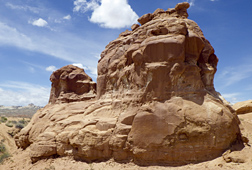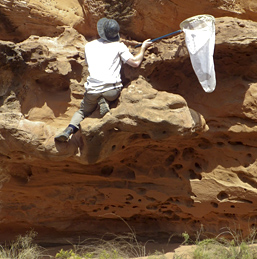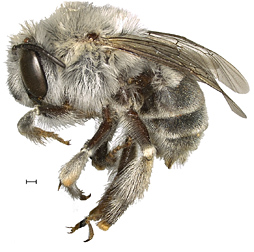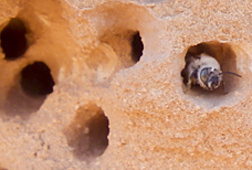|
|
 A column of sandstone rock riddled with A. pueblo nests at a collection site in the southwestern United States. |
 Sweep net in hand, Utah State University graduate student Michael Orr scales a sandstone rock face to capture A. pueblo bee specimens. |
 Side shot of an adult female A. pueblo bee. Scale bar below is at one-half millimeter. |
|
|
Rock-boring Bee Named after Ancient Pueblo Native-American Cliff Dwellers
By Jan Suszkiw
September 12, 2016
Utah State University (USU) graduate student Michael Orr rummaged through drawer after drawer at the National Pollinating Insects Collection until his doggedness paid off. Inside one drawer, he spied what he'd been seeking: specimens of an unnamed, fuzzy gray bee and their nests-carved into chunks of sandstone.
Could these bees have made the same sandstone nests he had observed nearly a year before at the Grand Staircase-Escalante National Park in Utah? Intrigued, Orr contacted Frank Parker, a retired Federal researcher who first found the specimens 40 years ago for confirmation on the drawer's contents. He then devised a plan to learn more, subsequently piecing together clues about the bee's identity and nesting behavior gathered from sites in seven southwestern states, including Puebloan cliff dwellings at Mesa Verde National Park in Colorado.
This month in the journal Current Biology, Orr and his mentors from USU and the Agricultural Research Service (ARS) report their findings about the strange but tenacious sandstone bee. They named it Anthophora pueblo, in recognition of ancestral Puebloans who skillfully built their dwellings in cave entrances and cliff faces more than 700 years ago, mainly in what's now the Four Corners region consisting of Utah, Colorado, New Mexico and Arizona.
Orr, who is preparing his dissertation in biology, began his sandstone bee investigations by consulting with Parker, a former research leader of ARS's Pollinating Insects Biology, Management and Systematics Research Unit in Logan, Utah.
Together with mentors James Pitts (USU Department of Biology) and Terry Griswold (ARS-Logan), Orr conducted laboratory and field work to expand on what Parker could tell him about the 10- to 15-millimeter-long native bee, which uses its powerful mandibles and water to tunnel into certain types of soft sandstone rock-whether on cliff sides or the walls of Puebloan structures.
Among the team's findings:
- The bee's investment in time and energy-including wear and tear on its mandibles—is well worth the protection it gains from nest-invading beetles, predators, pathogens and even flash floods.
- Generations of A. pueblo bees will inhabit and even add to the nest tunnels begun by forebearers—with thousands of tunnel entrances sometimes pitting the rock face.
- The durable nature of the sandstone nests allows young bees to stay put for a few years, and they emerge only when flower blooms are at their peak-a behavior the researchers call "bet-hedging."
These and other survival tricks make A. pueblo an interesting generalist pollinator and important contributor to the health of southwestern desert ecosystems. But the species' preference for sandstone nesting habitat may preclude its managed use in large-scale crop production areas similar to that of honey bees or certain types of bumble bees, notes Diana Cox-Foster, current research leader of ARS's Logan bee lab.
She adds that Native-American growers in the region want to learn more about the sandstone bee, especially its potential to pollinate native desert plants of medicinal importance, which are sustainably harvested from the land. Orr, meanwhile, hopes to study the genetic interrelatedness of sandstone communities of the bee—answering, for example, whether they comprise separate populations or work together as "one big happy family."
ARS is the principal in-house research agency of the U.S. Department of Agriculture.

